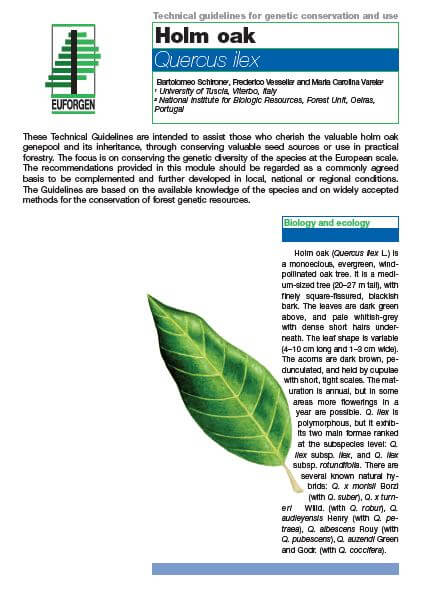Quercus ilex - Technical guidelines for genetic conservation of Holm oak
Seed propagation for high forests is the most suitable management method to maintain and increase genetic diversity and, therefore, the conservation of the genetic resources of the species. It is the most adequate regime for landscape protection, ornamental and recreational functionalities. High forest merits are also on the use of water, which is a special feature for Mediterranean regions where increasing human demands for water are expected together with climate change induced drought (Gracia, 2009).
Coppices for firewood production (coppicing every 30–40 years) usually host a large amount of the biodiversity of Mediterranean ecosystems, but reduce the genetic diversity of the coppiced species, in particular where up growing single stems per stump are not left. Therefore, the chance to convert coppices into high forests, through a gradual increase of the number of single stems per stump, should be considered. For instance, a coppice stand with a single stem per stump system, with long cycles (not less than 40 to 50 years) and a large number of seed-bearing trees (even >200), contributes to the regeneration of the population and the maintenance of the understory and favours the natural evolution of Q. ilex towards its climax situation (which is pure high forest).
Holm oak hybridizes with other oak species and hybridization may result in a loss or an increase of genetic diversity according to the concrete situation of the population or species evolution (Soltis & Soltis, 2009). Where populations for conservation of genetic resources are established in mixed oak- stands, hybridization monitoring is recommended, whenever possible through genomics, transcriptomics and progeny testing.
Since limited genetic information about Q. ilex is available, it is recommended that genetic conservation programmes start with the following objectives: conservation of endangered, marginal populations and habitats of Q. ilex; sampling the genetic diversity; establishment of Dynamic Conservation Units based on long term autochthony, high biodiversity value and location in ecologically diverse regions of large populations (> 1000 individuals).
Authors: Bartolomeo Schirone; Federico Vessella; Maria Carolina Varela
Journal/Series:
EUFORGEN Technical Guidelines for Genetic Conservation and Use
Publication Year: 2019
Publication Format: PDF
ISBN 13: 978-952-5980-62-2
Language: EN
Pages: 6 p.
Technical guidelines Quercus ilex

